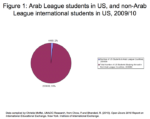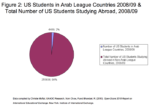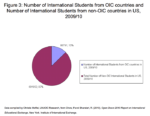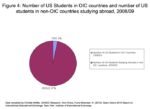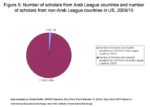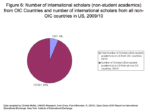The High-Level Group Report of the Alliance of Civilizations emphasizes exchanges as an “effective method for overcoming cultural barriers, enhancing intercultural awareness and fostering individual development.”
What is the state of academic exchanges between Muslim and Western countries?
As a first step, the UNAOC Research and Education department has compiled figures for academic exchanges between the Arab and Muslim countries and the United States. These figures show the urgent need for expansion of these exchanges.
All data is compiled from P. Chow and R. Bhandari, (2010), Open Doors 2010 Report on International Educational Exchange, published in New York by the Institute of International Exchange. Since the data in Open Doors is classified on the basis of region, UNAOC research recompiled the data. As a proxy for Arab countries, we used member countries from the League of Arab States; and as a proxy for the Muslim world, we used member countries from the Organization of the Islamic Conference.
Figure 1 depicts the number of international students from League of Arab State countries in the US, vis-à-vis the number of international students from non-League of Arab States countries in the US for 2009/10. Approximately 5 percent (31, 583) of the total number of international students came from 22 member countries of the League of Arab States.
Figure 2 depicts the number of US students in League of Arab State countries vis-à-vis the number of US students studying abroad in 2008/09 in non-Arab League countries. In 2008/09, just about 2 percent (4,489) of the US students studied in Arab countries.
Turning to the larger Muslim world, about 13 percent (88791) of the total number of international students in the US were from OIC countries in 2009/10, as depicted in Figure 3. The number of US students who went to OIC countries was about 3 percent of the total number of students who studied abroad in 2009/10, as depicted in Figure 4.
The High-Level Group report emphasized exchanges also at the post-graduate level, notably those of researchers and professors. These kinds of exchanges are crucial not only for overcoming cultural misunderstandings, but to build the bridges that provide a sustainable infrastructure to support exchanges of all types.
About 2 percent of the scholars in the US in 2009/10 were from the Arab world (See Figure 5), and about 6 percent of the scholars in the US were from the OIC countries (see Figure 6).
Arab Muslim World US Exchange Stats [PDF]

